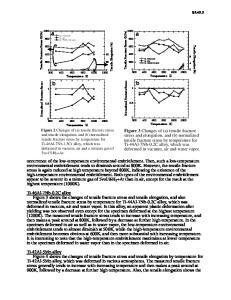Impurity Effects on the Environmental Stability of Powder Processed Intermetallic Alumino-Silicide Compounds
- PDF / 2,954,621 Bytes
- 14 Pages / 612 x 792 pts (letter) Page_size
- 0 Downloads / 268 Views
M.J. Kaufmanb) University of North Texas, Department of Materials Science and Engineering, Denton, Texas 76203-5310 (Received 3 November 2004; accepted 7 June 2005)
The evolution of nearly dense stoichiometric silicide compacts via powder processing is presented in this paper. For specific single-phase Mo(Si,Al)2 compacts, room-temperature environmental degradation, phenomenologically similar to the pesting behavior of binary MoSi2 was observed. This degradation occurs over a series of a few months and results in grain boundary decohesion, which leads to crumbling of polycrystalline compacts in air at room temperature. Auger electron spectroscopy, transmission electron microscopy, and energy dispersive spectroscopy of the boundaries revealed the presence of an array of lens-shaped particles each comprised of silicon carbide and aluminum. The reaction of these phases with atmospheric species was accelerated by the presence of humidity. The trace presence of carbon was unavoidable due to the use graphite pressing dies. Alloying additions were made to tie up carbon by forming more stable carbides while maintaining the desired matrix phase stoichiometry. The pest phenomenon and alloying remedy were proven applicable to other silicide systems through experimentation and ThermoCalc modeling.
I. BACKGROUND
Molybdenum disilicide is an intermetallic material being considered for application in high-temperature environments. In addition to its high melting point (2020 °C)1 and moderate density (6.24 g/cm3),2 this material also displays excellent high-temperature oxidation resistance due to the formation of an adherent, glassy silica scale, which acts to passivate the surface. However, at lower temperatures (400–600 °C), the material undergoes “pest” oxidation, which results in the catastrophic degradation of monolithic parts at accelerated rates. Fortunately, a preoxidation step can be performed, which will reduce the sensitivity of MoSi2 in this intermediate temperature regime. Despite its intrinsic deficiencies, molybdenum disilicide has found great utility in heating elements and nozzle linings. In attempts to improve the utility of MoSi2, both composting and alloy-approaches have been used in hopes of imparting better mechanical properties. The goal of the latter approach seeks to eliminate the intrinsic deficiencies, such as the low symmetry
Address all correspondence to these authors. a) e-mail: [email protected] b) e-mail: [email protected] DOI: 10.1557/JMR.2005.0329 J. Mater. Res., Vol. 20, No. 10, Oct 2005
http://journals.cambridge.org
Downloaded: 15 Mar 2015
crystal structure, without compromising the desirable attributes. The aim of alloying MoSi2 is to produce higher symmetry crystal structures by atomic replacement of either the molybdenum or silicon atoms while maintaining the overall MX2 stoichiometry. Substitutional alloying of molybdenum silicides can be performed by replacing either the molybdenum or silicon atomic site with an appropriate atomic species. Much of the substitutional alloying i
Data Loading...











